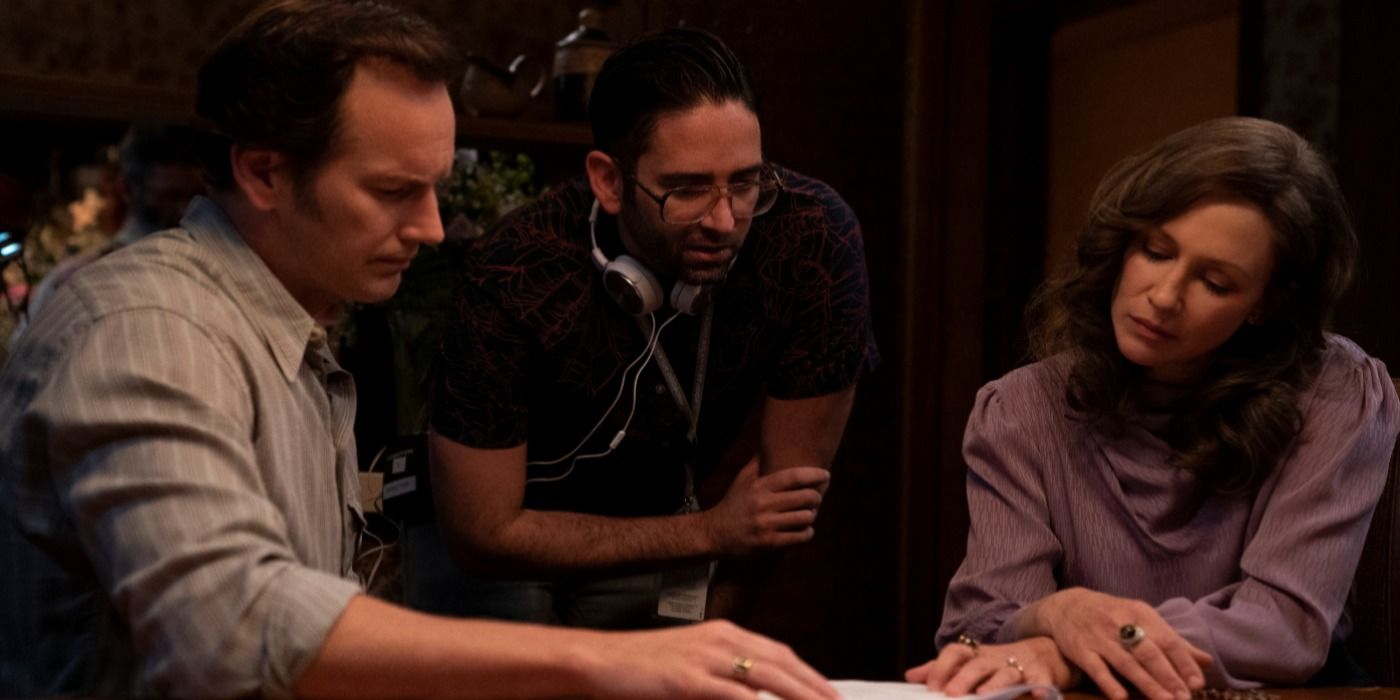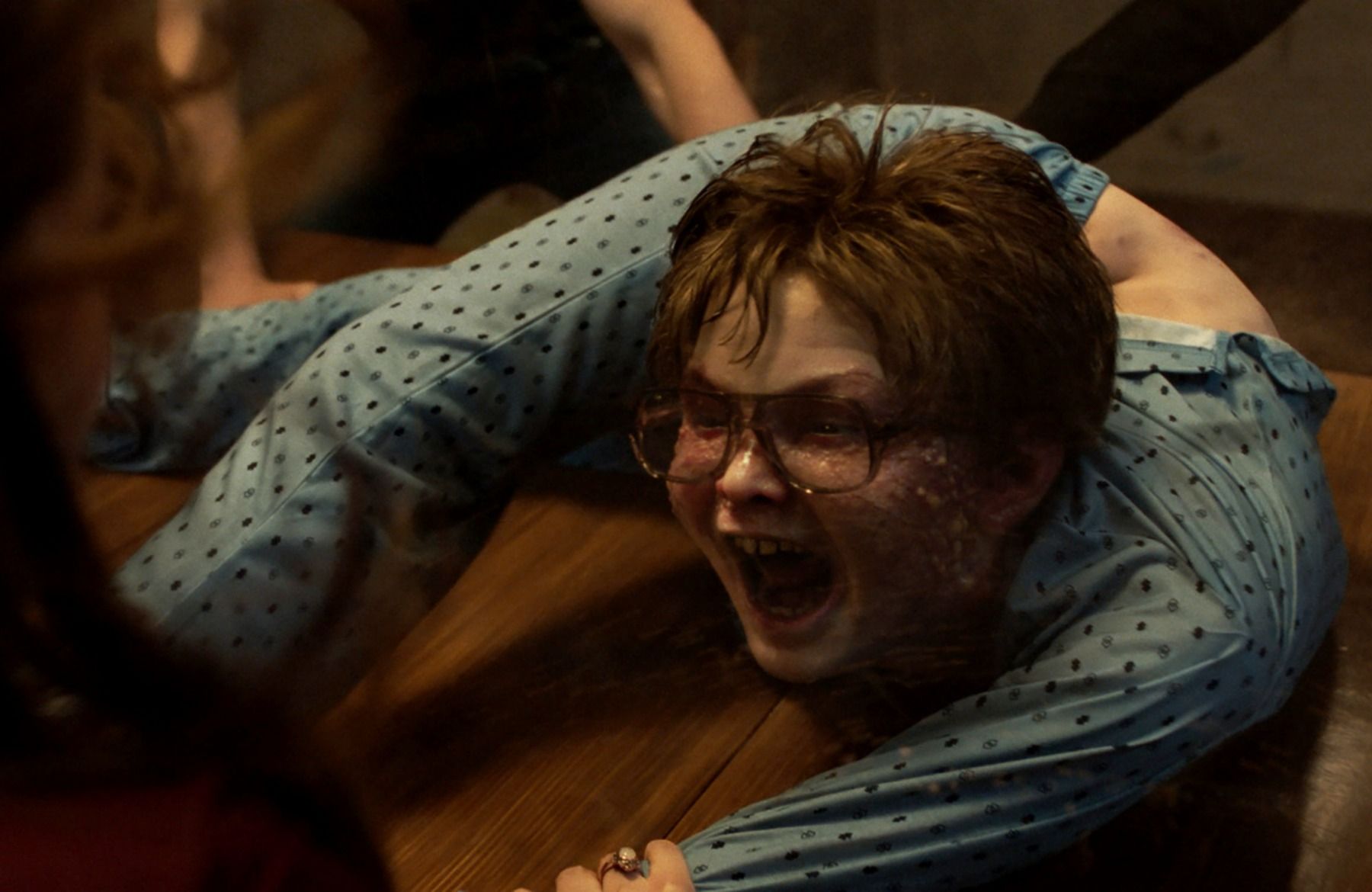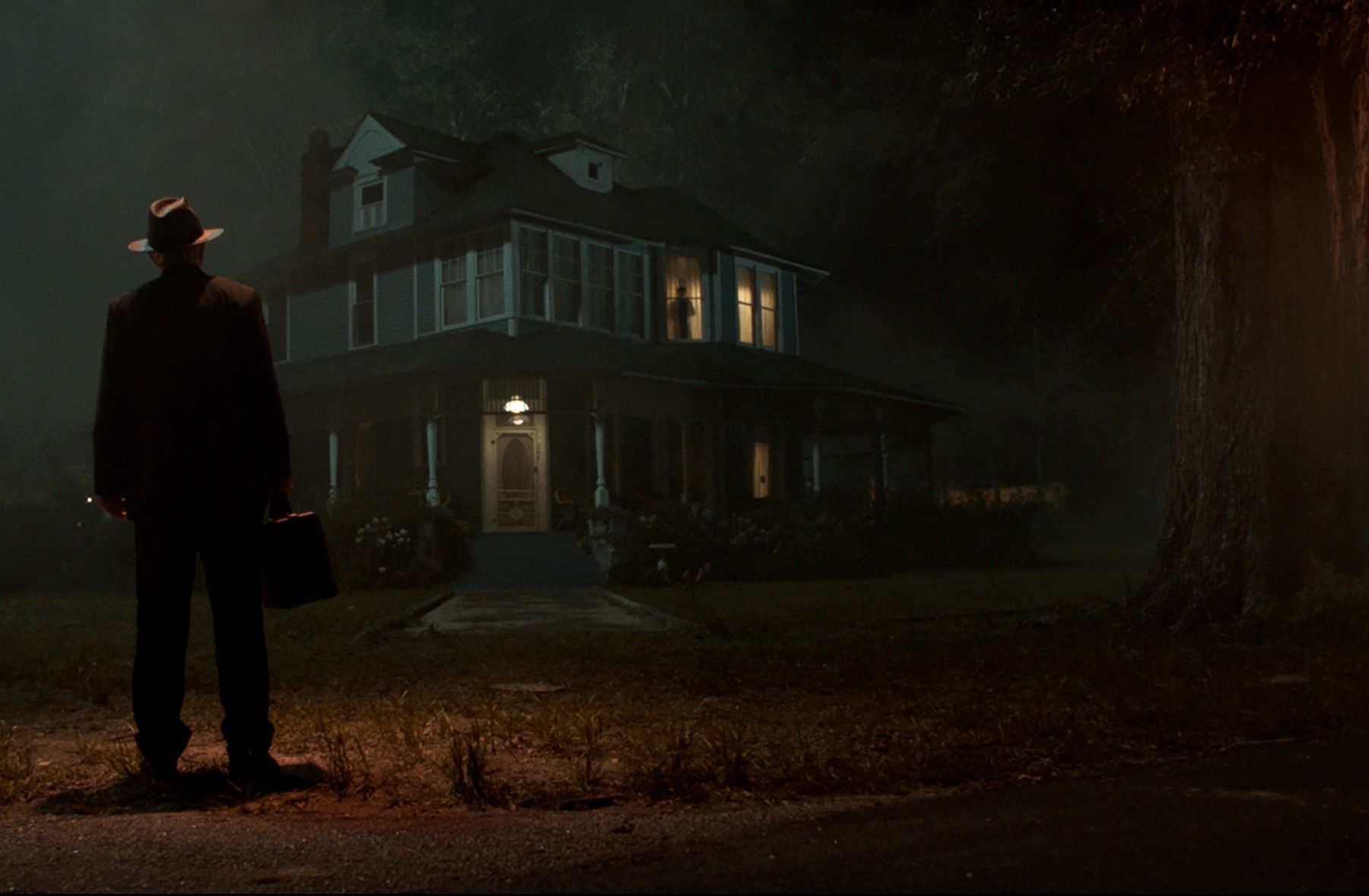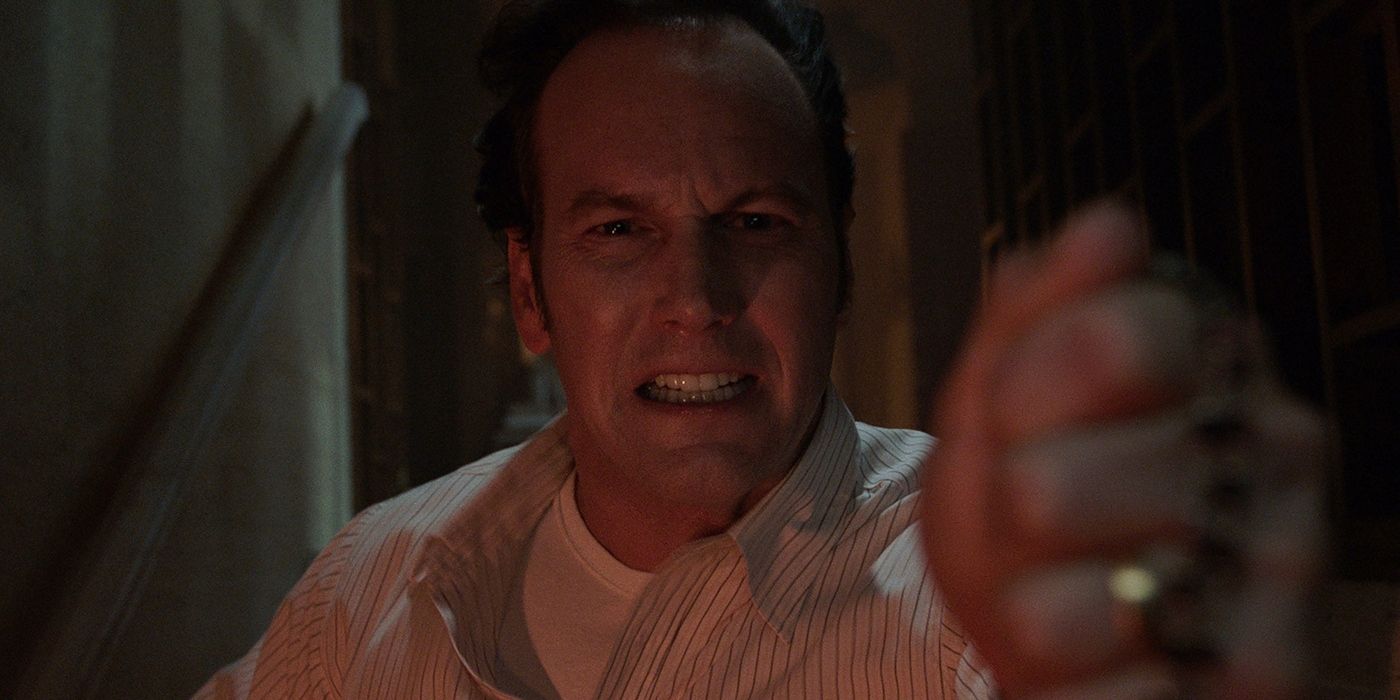From director Michael Chaves (The Curse of La Llorona), the latest installment in the largest horror franchise in history, The Conjuring: The Devil Made Me Do It, has all of the terrifying scares and nail-biting thrills that fans have become accustomed to, while also including the extra added layer of one of the most sensational cases from the files of real-life paranormal investigators Ed (Patrick Wilson) and Lorraine Warren (Vera Farmiga). When the exorcism of a young boy named David Glatzel (Julian Hilliard) doesn’t quite go as expected, it leads to a murder where the suspect is claiming demonic possession as a defense and things quickly spiral for all involved.
Following all safety protocols, Collider was recently invited out to Warner Bros. Studios to watch the first 11 minutes of the seventh film in the Conjuring universe and get a feel for where they’re taking the story next. Afterwards, in a 1-on-1 chat, filmmaker Michael Chaves talked about what sets this particular movie apart from the others, approaching this film as a fan of the franchise, weaving a Warren case file with the legal drama genre, expanding the rules and expectations, the changes they made, how they shot the contortions for David’s exorcism, and deciding when to show things and when to pull back.
Collider: God versus the Devil stories are always so terrifying, especially when it involves children.
MICHAEL CHAVES: It’s funny, from the first read of the script, I learned that it was gonna open with the exorcism of David, which is a real Catholic-approved exorcism that happened. I rewatched The Exorcist a bunch of times, because that feels like the definitive exorcism of a child movie, and I was like, “How can I top this? There’s no way. This is such a legendary movie.” That’s why I put a nod to it, when the priest rolls up. But year, it is funny how that is something that always works. It seems like the demonic forces always wanna go for children.
And it seems like an impossible task to cast a child, knowing what you’re going to put them through.
CHAVES: Yeah. We lucked out with Julian [Hilliard]. Julian was coming off The Haunting of Hill House. He’s just such a great little actor. He comes on set, fully prepared like a little adult. With him, it’s like working with a little adult. He’s really great. He had a great attitude. You could tell he just really enjoyed it. His mom coaches him and is really an incredible ally in the process, just getting him to understand the material and be prepared for it. His whole family is like really lovely.
How is it to go about approaching something like this, where you know that you’re making a third movie and you’re taking characters that James Wan has directed? How do you make that your own and still make it the franchise that fans love?
CHAVES: First of all, when I got the script, I was freaking out. I was absolutely thrilled. Honestly, I’m a huge fan of The Conjuring, and the idea that I could direct the third one just sent me over the moon. I was ecstatic. I, like every other one of the millions of fans, was like, “Wait a second, James, isn’t gonna direct the third Conjuring?” So, I know how it feels. That balanced out my elation with getting the job. This is a franchise that has been started by one of the greatest horror directors of all time. He is the living master of horror. Those are big shoes to fill, without a doubt. In terms of putting my mark on it, honestly, that was not a priority. The biggest priority was, “I’m a fan of this franchise and I love these characters and I wanna make The Conjuring movie that I have not seen yet.” My mark is completely secondary. It’ll already be its own movie. It’ll already be its own story because it is such a different case and such a different story. This is much more of an investigation. Without a doubt, it is the bread and butter language of a Conjuring movie, as you’ve gotten a little glimpse at, but it takes the Warrens into places that we’ve never seen before. That, in itself, will feel like its own movie. I didn’t wanna try to be too self-conscious or self-aware, or try to make it any different than just the very best Conjuring movie that has come since the last two.
This really combines a Warren case file with the legal drama genre. How do you find a blend of that?
CHAVES: Well, the judge becomes demonic. No, just kidding. Actually, the court case plays a very small part of it. The trial is the backdrop of it. The movie ends with the verdict, but that’s much more in the backdrop. The core of that is the Warrens starting with this exorcism, and then we follow Arne through his possession, leading into the actual murder. It is the Warrens’ involvement through that, up until the end, as they’re trying to get to the bottom of what exactly happened. In the opening, things go awry and Lorraine is having visions. Lorraine is connected to something, and they’re on this journey to find out what that is. From the very beginning, I hit it off with James on La Llorona and one of the things we really share is a love of similar movies. We love Se7en, which is a big touchdown movie for us and, of course, for a lot of people. His idea was, “What if we did Se7en, but in The Conjuring universe?” And I was like, “Yes! Yes!” Of course, it’s its own brand of that. It’s what happens when you take them on the road.
Lorraine, especially in the ‘80s, started to work with police departments and detectives on missing person cases. Even though it’s an amalgamation in the movie of different events that happened in her life, that became a thing during the ‘80s, where you had psychics and clairvoyants working with detectives and Lorraine was one of them. It so much became a thing that in 1989, the Department of Justice issued this handbook, and you can get it off their site. It’s in their archives section and it’s about working with psychics and clairvoyants on missing persons cases. It’s inspired by a handful of different psychics, like Lorraine Warren, and that’s one of the elements that we pull into it. The X-Files is show that I love and I grew up on, where each case is a little different and has its own personality, and sometimes they solve it and sometimes they don’t. There’s more of an exploration with that. The first Conjuring was so great that the franchise has been going back to that classic haunted house format. With this, even though the first 11 minutes feel very haunted house, it’s almost the goodbye letter to the haunted house. What comes afterwards is what happens after that. It’s the fallout of what happens when it goes wrong. So, one of the big ideas with this was, let’s shake up the franchise a little bit.
Do you see this as more of a self-contained Conjuring movie, or do you see this as another step to further expanding the universe?
CHAVES: (Jokingly) This is phase two of the eight-phase Conjuring rollout. No. This definitely expands the rules and the expectations. They’re facing an adversary that they’ve never faced before, and that was the intention. Up to this point, it’s always been a demon. They’re always going after a demon. This is a case that takes place in real life in 1981. It’s furthest into their careers that we’ve seen so far on the screen. The idea is that it’s a new decade and a new chapter of their careers. The ‘80s was the time of the Satanic Panic. Even though it wasn’t quite called the Satanic Panic at the time because they didn’t really realize it was a panic, the seedling of that is an idea that we might play with in the movie. The fact that they were working with police departments becomes a thread, as well.
You’ve previously talked about this being the biggest and the darkest Conjuring movie. Was that something that you set out to do? Did you guys have conversations about that, or is that just how you saw it unfolding, once you started bringing it all to life?
CHAVES: That was really the case. They’re horror movies, so they’re shamelessly marketed as the darkest case yet, but I think this is the first one where it’s a real murder. There’s a real victim. That becomes part of the story and part of the storytelling, the idea that the Warrens are so great in the previous movies. Everything works out, except in the first one where the dog died. Usually, it always works out. I think it’s exciting to see, as we’ve seen this past year, that sometimes it doesn’t work out, so how do you find that path forward? How do you find the light in it? I grew up Catholic. I’m not practicing anymore, but it’s still in my roots and in my bones. That might be one of the reasons that I’m always drawn to this stuff. When it’s a haunted house experience and no one was hurt and people talk about it, that idea of, do I believe or do I not believe, is a playful thought experiment. It’s not really something that you have to come up with a decision about. But when someone has been murdered and a life has been taken, and then the person claims demonic possession, all of a sudden, do you believe in demons? We’re talking about a man’s life who’s lost, and another man’s life that’s on the line. All of a sudden, the stakes get raised, and the question of faith and what is right and what you believe, really does come to the forefront. When I first got the script, to this day, what’s been in my mind is telling the story right and delivering on something that lives up to The Conjuring thrill ride experience, but then also is aware of the real tragedy in it and the reality of it.
How close did the film ultimately end up being to the first script that you read? Were there any major changes that happened?
CHAVES: We actually expanded a character. There’s a character where the actor did a really great job and we just wanted more of them, so we went in and expanded that role. I won’t say who it was, but they did such a great job that everyone was like, “I think we need more of this person in the movie,” so we went back and got some more of them. And we did a little bit of a tweak of the way our villain’s story is resolved. I’ll leave it at that. Because it’s a different story and our villain is so different that figuring out the right way to handle that and get a resolution to that was something that we had to fine tune a little bit, but ultimately I’m very happy with the resolution that we got.
How challenging is it to figure out how real you want to be, like using a real exorcism, with also making a movie that’s fun to watch?
CHAVES: It’s tricky. I debated about that for everything. In the interviews, everybody talks about how he actually levitated. I’m not saying that nobody levitates in this movie. There might be some limitation in this movie. But there was something about the levitation in it, in that opening scene with our boy, where I just thought it would be more interesting if it felt more visceral and a little bit more messy. With some of it, you’re just working off of your gut and what feels right, but with that, I didn’t want it to feel too pretty. A kid levitating could almost feel non-threatening, especially with his little body. That doesn’t really feel like a substantial thing, and it’s kind of what you expect. You expect a levitation or something extraordinary like that. So, I just thought it might be more interesting if we played with the contortions.
There’s just something so creepy about someone contorting their body.
CHAVES: And that’s all in camera. That’s real and that is the speed. We did not speed it up, at all. Our contortionist is this little girl named Emerald Wulf, who was 12 years old at the time, and she did that all in camera and at that speed. Originally, it was planned to do it really slow, and we shot it and it was definitely cool. But afterwards, I was like, “Emerald, can you do anything else? Do you wanna try something else?” And she was like, “I could do it really fast.” I was like, “Show me that.” We weren’t rolling and she did it, and then everybody watching [silent]. It was like, “That was so weird, what we just saw. That’s definitely gonna go in the movie. We’re definitely gonna do that.” So, she did the fast version and it was crazy. Honestly, the leverage to be able to flip your body up, not even having your feet pegged down, is pretty insane. I struggled to get up off the ground sometimes.
With a movie like this, how do you decide how much to show and how much to leave to the audience’s imagination?
CHAVES: The Conjuring movies always play up what’s in the darkness, and there’s definitely an element of that in this. The goal is to always keep people on their toes, in terms of what the scary thing is and how the scenes are gonna play out, and what we’re showing and what we’re not showing is always part of that.
The Conjuring: The Devil Made Me Do It is in theaters and on HBO Max on June 4th.




